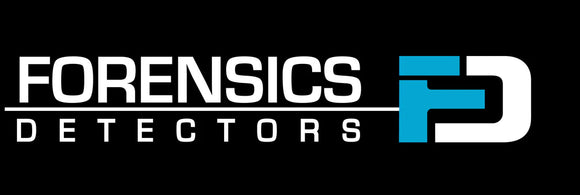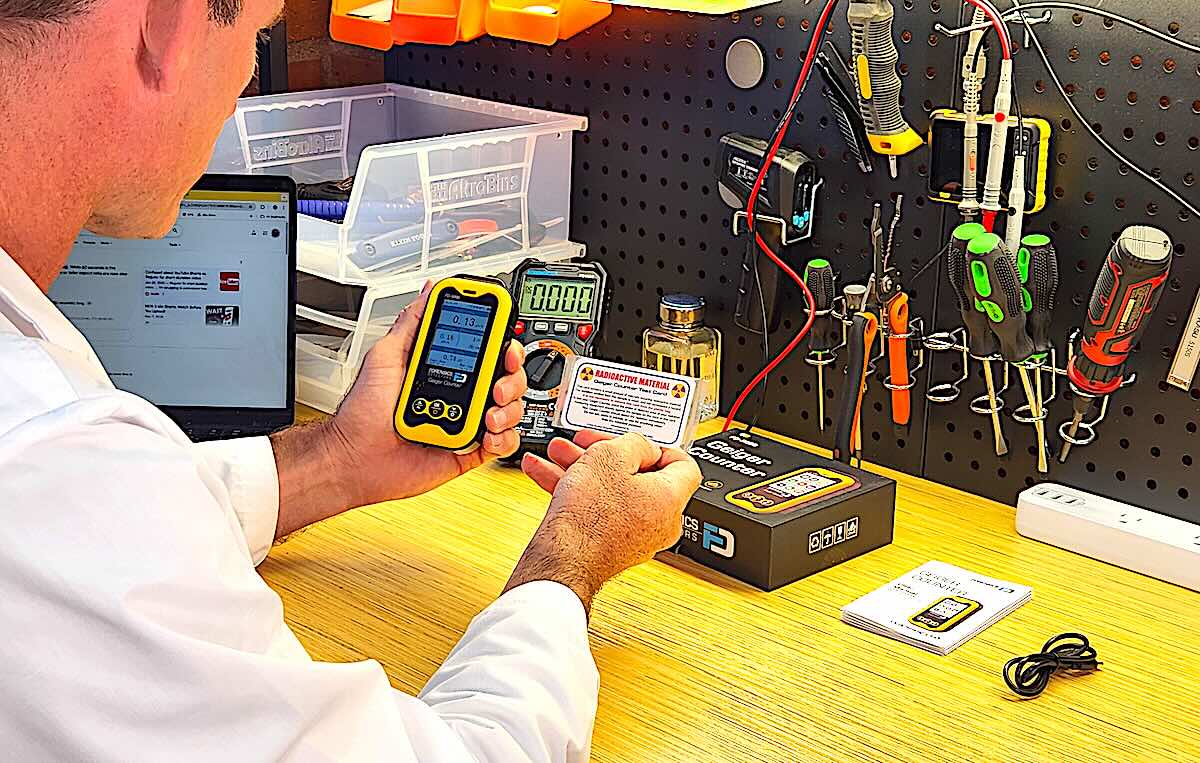A Geiger counter is a radiation detector measuring device that enables the detection of potentially harmful ionizing radiation. This radiation detector and Geiger counter function by registering electrical pulses created when radiation particles enter a gas-filled tube (called a GM tube), producing the classic clicking sound that increases with radiation intensity. The radiation detector and Geiger counter offer safety in nuclear facilities and medical settings for environmental monitoring after nuclear incidents, and enable scientific research involving radioactive materials.
| Pros | Cons |
|---|---|
| ✅ Provides immediate radiation detection with alarms. | ⛔ Cannot identify all radioactive isotopes. |
| ✅ Portable and easy to operate in the lab or the field. | ⛔ Limited accuracy at very high radiation levels due to saturation. |
| ✅ Detects multiple radiation types (x-rays, beta, gamma). | ⛔ Need radiation sources for bump testing. |
| ✅ Very affordable. Comes with FREE radiation card. | ⛔ May not detect low-level radiation effectively. |
Best Geiger Counter
- Forensics Detectors Geiger Counter
- Geiger Counter PCE-RAM 5
- Geiger Counter Nuclear Radiation Detector - MESTEK
- GQ GMC-600 Plus Geiger Counter Radiation Monitor
What Is A Geiger Counter?
A Geiger counter is a handheld electronic device that detects and measures ionizing radiation. Named after Hans Geiger, it contains a Geiger-Müller tube filled with inert gas that generates electrical pulses when struck by radiation particles. These pulses are converted into audible clicks or digital readings displayed in units like microsieverts or counts per minute. Originally developed in the early 1900s, modern Geiger counters have evolved into portable, user-friendly instruments essential for radiation safety monitoring in various professional and personal applications.
Who Needs A Geiger Counter?
Geiger counters are essential tools for nuclear facility workers, radiologists, and emergency responders who need to monitor radiation exposure. Scientists and researchers use them when working with radioactive materials or studying radiation effects. Mining professionals rely on them to detect naturally occurring radioactive minerals. Environmental specialists employ them for contamination assessment after nuclear incidents. Homeowners in radon-prone areas or near nuclear facilities may use them for peace of mind. Amateur rock collectors use them to identify radioactive specimens. Some travelers carry them when visiting regions with a nuclear history.
What Is The Difference Between a Geiger Counter And a Radiation Detector?
A Geiger counter represents a specific type of radiation detector using gas ionization technology, while "radiation detector" is a broader term encompassing various detection technologies. Geiger counters specifically use a Geiger-Müller tube and are optimized for general radiation detection with distinctive clicking sounds.
How Does a Geiger Counter Work?
A Geiger counter works through a process called gas ionization. The device contains a Geiger-Müller tube filled with inert gas (typically argon or helium) and a thin wire electrode running through its center. When radiation particles enter the tube, they collide with gas molecules, creating ion pairs. A high voltage applied between the tube wall and electrode creates an electric field. These newly created ions accelerate toward the electrodes, causing a cascade of ionization known as a Townsend avalanche. This brief electrical discharge creates a pulse that's amplified and registered as a click sound or digital reading.
Are Geiger Counters Dangerous to Use?
Geiger counters themselves pose no danger to users as they are passive detection instruments that don't generate or emit radiation. They simply detect existing radiation in the environment. Modern devices operate on low-voltage batteries, eliminating electrical hazards. The primary safety consideration involves proper interpretation of readings to avoid unnecessary radiation exposure.

What Types of Radiation Can a Geiger Counter Detect?
Geiger counters can detect alpha, beta, and gamma radiation, though with varying efficiencies. Alpha particles (helium nuclei) are detected only when the window of the GM tube is very thin and placed extremely close to the source. Beta particles (electrons) are more penetrating and easily detected through standard mica windows. Gamma rays (high-energy photons) are highly penetrating and detected efficiently through the tube walls. Some advanced models can also detect X-rays. Most Geiger counters cannot distinguish between radiation types without additional shields or filters. Neutron radiation typically requires specialized detection equipment.
Does A Geiger Counter Need Calibration?
Yes, Geiger counters require periodic calibration to ensure accurate measurements. Over time, components age and sensitivity can drift, affecting reading accuracy. Calibration involves exposing the device to known radiation sources and adjusting its response accordingly. Professional calibration is typically recommended annually for devices in critical applications. Many manufacturers offer calibration services or certificates with new devices. Some advanced models feature self-calibration routines. In high-radiation environments, more frequent calibration may be necessary. Proper calibration is essential for legal compliance in professional settings and for reliable health and safety monitoring.
What Is the Detection Limit of a Geiger Counter?
The detection limit of a Geiger counter typically ranges from background radiation levels (0.01μSv/h) up to about 50 mSv/h for standard models. Consumer-grade units generally have lower maximum detection capabilities than professional models. Detection efficiency varies by radiation type: gamma radiation detection is typically 1-10%, while beta detection can reach 30-90% depending on energy levels. Alpha particles require specialized thin-window detectors. At very high radiation levels, Geiger counters may experience "saturation," where the tube cannot recover between pulses, causing artificially low readings. Modern digital models often incorporate dead-time correction algorithms to compensate for this limitation.
How Do I Read a Geiger Counter?
Reading a Geiger counter involves understanding both audible and visual outputs. The clicking sound indicates radiation detection—faster clicking means higher radiation levels. Digital displays show measurements in units like microsieverts per hour (μSv/h), milliroentgens per hour (mR/h), or counts per minute (CPM). Modern devices may feature color-coded alerts or threshold warnings. Context matters—readings should be compared to background radiation levels, typically 0.1-0.3 μSv/h. Some advanced models display accumulated dose over time. Most units have multiple detection modes and sensitivity settings that affect readings. Always consult your specific model's manual for accurate interpretation.
What Is the Safe Level of Radiation?
Safe radiation levels depend on context and duration of exposure. Natural background radiation averages 2.4 millisieverts (mSv) annually worldwide. Regulatory bodies typically limit public exposure to 1 mSv/year above background from artificial sources. Occupational limits for radiation workers range from 20-50 mSv annually, depending on the country. Acute exposure under 100 mSv rarely produces detectable health effects, while doses exceeding 1,000 mSv can cause radiation sickness.
Radiation Exposure Limits by Government Agencies
Public Exposure Limits
| Agency | General Public Limit | Notes |
|---|---|---|
| NRC/EPA/International | 1 mSv (100 mrem) per year | Above natural background radiation |
| German Federal Office for Radiation Protection (BfS) | 1 mSv per calendar year | Excludes medical applications |
| BfS - Public Organ Specific | 15 mSv per year (eye lens), 50 mSv per year (skin) | Specific tissue limits |
Occupational Exposure Limits
| Agency | Occupational Limit | Notes |
|---|---|---|
| OSHA (US) | 1.25 rem (12.5 mSv) per quarter for whole body | For head, trunk, blood-forming organs, lens of eyes, gonads |
| OSHA (US) | 18.75 rem (187.5 mSv) per quarter | For hands, forearms, feet, and ankles |
| NRC/International | 20 mSv (2 rem) per year | Standard occupational limit since 1957 |
| German BfS | 20 mSv per calendar year | Can allow up to 50 mSv in a single year (not exceeding 100 mSv in 5 years) |
| German BfS | Maximum 400 mSv lifetime occupational exposure | Career limit |
Special Population Limits
| Population | Limit | Agency |
|---|---|---|
| Pregnant Workers | 1 mSv for the duration of pregnancy after declaration | German BfS |
| Pregnant Workers | 500 mrem (5 mSv) for the gestation period, recommended 50 mrem (0.5 mSv) per month | US Federal Regulations |
| Women of childbearing age | 2 mSv per month to the uterus | German BfS |
| Minors (under 18) in the workplace | 1 mSv per calendar year | German BfS |
| Children (research subjects) | 300 mrem (3 mSv) single exposure, 500 mrem (5 mSv) annual | US Federal Regulations |
Space and Emergency Response Limits
| Situation | Limit | Notes |
|---|---|---|
| Astronauts | 25,000 mrem (250 mSv) per Space Shuttle mission | Highest recommended limit |
| Emergency Response | Special guidelines exist | See EPA PAG Manual for radiological incidents |
Natural Background Radiation
| Source | Typical Exposure |
|---|---|
| Average background radiation worldwide | 2.4 mSv (240 mrem) annually |
| Range | Varies by location and elevation |
Can Geiger Counters Be Used for Food Safety Testing?
Geiger counters have limited utility for comprehensive food safety testing. They can detect significant radioactive contamination but lack the sensitivity and specificity needed for regulatory compliance. Food typically requires more sophisticated equipment like gamma spectrometers, which can identify specific radioactive isotopes and their concentrations. Geiger counters cannot distinguish between naturally occurring radiation (like potassium-40 in bananas) and concerning contaminants. False positives and negatives are common with food testing. Professional food safety protocols involve laboratory analysis with sample preparation. For concerned consumers, Geiger counters provide only preliminary screening.
Can Geiger Counters Detect Neutron Radiation?
Standard Geiger counters cannot directly detect neutron radiation because neutrons don't ionize gas in the Geiger-Müller tube. Neutrons are electrically neutral particles that pass through the detector without interaction. Specialized neutron detection requires modified instruments with materials like boron trifluoride or helium-3 that produce detectable charged particles when struck by neutrons. Some advanced radiation meters include separate neutron detection components alongside traditional Geiger tubes. Professional neutron detection often employs "rem counters" or "neutron survey meters" specifically designed for this purpose. In nuclear facilities where neutron radiation is a concern, specialized equipment is mandatory for comprehensive safety monitoring.
Can Geiger Counters Detect Radon Gas?
Standard Geiger counters cannot effectively detect radon gas itself as it's an inert, colorless, odorless radioactive gas. However, they can detect the alpha and beta radiation emitted by radon's decay products (polonium, lead, bismuth) when these particles settle on surfaces. For accurate radon measurement, specialized radon detectors like charcoal canisters, alpha track detectors, or electronic continuous monitors are required. These devices measure radon concentration in air, typically expressed in picocuries per liter (pCi/L) or becquerels per cubic meter (Bq/m³). Long-term testing (3+ months) provides more reliable results than short-term measurements due to radon's natural fluctuation patterns.
Final Word
When selecting the best Geiger counter, consider the balance between accuracy, durability, and user-friendliness based on your specific needs. Professional-grade models offer comprehensive detection capabilities and data logging, while consumer options provide good value with digital displays and multiple radiation measurements. Key factors include portability, battery life, detection range, and sensitivity to different radiation types. The ideal Geiger counter combines reliable radiation detection with intuitive operation, allowing both professionals and concerned citizens to monitor radiation levels effectively and make informed safety decisions about potential exposure risks.
About The Author
Dr. Kos Galatsis ("Dr.Koz") is the President of FORENSICS DETECTORS where the company operates from the scenic Palos Verdes Peninsula in Los Angeles, California. He is a subject matter expert on gas sensor technology, gas detectors, gas meters, and gas analyzers. He has been designing, building, manufacturing, and testing toxic gas detection systems for over 20 years.

Every day is a blessing for Dr. Koz. He loves to help customers solve their unique problems. Dr. Koz also loves spending time with his wife and his three children, going to the beach, grilling burgers, and enjoying the outdoors.
Read more about Forensics Detectors.
Email: drkoz@forensicsdetectors.com

